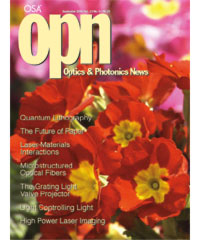
September 2002 Issue
- Quantum Lithography
- Optical Technology and Paper Management in the 21st Century
- Focus Fluctuations in Laser-Materials Interactions
- Microstructured Optical Fibers
- Light Controlling Light with Enhanced Kerr Nonlinearity
- The Grating Light Valve Projector
- Imaging with High-Power Lasers
- Browse all Issues
Feature Articles
Quantum Lithography
Optical lithography is used in the manufacture of microchips to etch patterns on silicon wafers. Because of diffraction, the size of these patterns is limited by the wavelength of the light used. The authors present a new lithographic protocol that uses the quantum properties of light. With this new technique, it is possible to beat the diffraction limit and, in principle, continue the miniaturization process until the atomic scale is reached.
by Pieter Kok, Samuel L. Braunstein, and Jonathan P. DowlingOptical Technology and Paper Management in the 21st Century
There’s a lot of truth to the saying that “Gutenberg made everyone a reader, Xerox made everyone a publisher, and the personal computer is making everyone an author.” What changes in document management are on the horizon? The focus of this article is the changing role of paper in the dissemination and storage of information.
by Gary K. StarkweatherFocus Fluctuations in Laser-Materials Interactions
In laser-materials processing, the maximization of workpiece quality depends in part on optimizing conditions of laser beam size and fluence. Taking as an example the case of misfocus in sharp threshold laser ablation, the author describes the quality variations in laser-material processing that can be caused by a moving workpiece that jitters in and out of the laser beam's focal plane. He also discusses the possibility of engineering specific materials for improved misfocus tolerance.
by Dana D. DlottMicrostructured Optical Fibers
Microstructured optical fibers have unique properties that offer an opportunity to manipulate light in new ways, providing a platform for a novel class of all-fiber photonic devices. The authors review recent developments in the design and application of microstructured optical fibers for tuning and switching optical signals.
by Charles Kerbage and Benjamin J. EggletonLight Controlling Light with Enhanced Kerr Nonlinearity
The Kerr nonlinear index of refraction of a three-level atomic medium can be greatly enhanced by atomic coherence induced by two laser beams. Such electromagnetically induced transparency (EIT) media can be used to generate efficient nonlinear optical processes at low light intensities. Control and enhancement of Kerr nonlinearity in EIT media can be useful in all-optical communication, all-optical computing, and quantum information processing.
by Min Xiao, Hai Wang, and David GoorskeyThe Grating Light Valve Projector
An optical projector using grating light valves (GLV) as a spatial light modulator array has been demonstrated. A GLV projector uses a combination of lasers and microelectrical mechanical systems (MEMS) to produce a high-definition image suitable for a variety of different projector applications.
by Shigeo Ray KubotaImaging with High-Power Lasers
Imaging with high-power lasers produces excellent quality pictures with very well controlled pixels. Two different mechanisms are used to create the pixels: one that modifies the surface adhesion of the image layer, and another that ablates the material. These methods can be used for a variety of applications, including creation of black and white images, color images, and images on metallic surfaces.
by Fawwaz HabbalDepartments and Columns
Experiments With Polarization Part I: Sunglasses
In this issue of OPN, OSA Fellow Keigo Iizuka presents the first of a series of hands-on experiments he developed to spark interest in optics among members of the general public.
Interview with Elizabeth Rogan
In an interview with OPN, OSA’s new executive director, Elizabeth Rogan, reflects on her first few months on the job and on the challenges ahead.
OSA’s First Journal: JOSA 1917-61
In this issue, OPN Contributing Editor John N. Howard describes another milestone in OSA history: the Society’s first foray into journal publishing.
Optical Farming
Just outside the nation’s capital—on land traversed by superhighways and surrounded by suburban sprawl—corn grows, cattle graze, pigs root, tractors plow, and researchers apply 21st century science to the millennia-old challenge of wresting food from the land.
What Is Innovation?
This is the first in a series of articles that will explore entrepreneurship as it pertains to our industry. The primary goal of the quarterly column is to assemble and dissect known business and management intelligence that is critical for successful companies to earn respectable profits. The first installment in the series discusses innovation and its forms, since innovation is where the entrepreneurial process really begins.


![A multiplexed image of a human tonsil acquired. [NIAID] using the iterative bleaching extends multiplexity (IBEX) method.](https://opnmedia.blob.core.windows.net/$web/opn/media/images/articles/2024/0424/departments/202404-cover-web.jpg?ext=.jpg)
